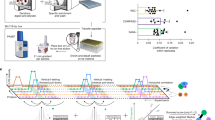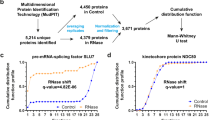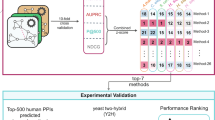Abstract
Plasmodium falciparum causes the most severe form of malaria and kills up to 2.7 million people annually1. Despite the global importance of P. falciparum, the vast majority of its proteins have not been characterized experimentally. Here we identify P. falciparum protein–protein interactions using a high-throughput version of the yeast two-hybrid assay that circumvents the difficulties in expressing P. falciparum proteins in Saccharomyces cerevisiae. From more than 32,000 yeast two-hybrid screens with P. falciparum protein fragments, we identified 2,846 unique interactions, most of which include at least one previously uncharacterized protein. Informatic analyses of network connectivity, coexpression of the genes encoding interacting fragments, and enrichment of specific protein domains or Gene Ontology annotations2 were used to identify groups of interacting proteins, including one implicated in chromatin modification, transcription, messenger RNA stability and ubiquitination, and another implicated in the invasion of host cells. These data constitute the first extensive description of the protein interaction network for this important human pathogen.
This is a preview of subscription content, access via your institution
Access options
Subscribe to this journal
Receive 51 print issues and online access
$199.00 per year
only $3.90 per issue
Buy this article
- Purchase on Springer Link
- Instant access to full article PDF
Prices may be subject to local taxes which are calculated during checkout



Similar content being viewed by others
References
Breman, J. G. The ears of the hippopotamus: manifestations, determinants, and estimates of the malaria burden. Am. J. Trop. Med. Hyg. 64, 1–11 (2001)
Ashburner, M. et al. Gene ontology: tool for the unification of biology. The Gene Ontology Consortium. Nature Genet. 25, 25–29 (2000)
Gardner, M. J. et al. Genome sequence of the human malaria parasite Plasmodium falciparum. Nature 419, 498–511 (2002)
Sibley, C. H. et al. Yeast as a model system to study drugs effective against apicomplexan proteins. Methods 13, 190–207 (1997)
Formstecher, E. et al. Protein interaction mapping: a Drosophila case study. Genome Res. 15, 376–384 (2005)
Giot, L. et al. A protein interaction map of Drosophila melanogaster. Science 302, 1727–1736 (2003)
Barabasi, A. L. & Oltvai, Z. N. Network biology: understanding the cell's functional organization. Nature Rev. Genet. 5, 101–113 (2004)
Rives, A. W. & Galitski, T. Modular organization of cellular networks. Proc. Natl Acad. Sci. USA 100, 1128–1133 (2003)
Bader, G. D. & Hogue, C. W. An automated method for finding molecular complexes in large protein interaction networks. BMC Bioinformatics 4, 2 (2003)
Fan, Q., An, L. & Cui, L. Plasmodium falciparum histone acetyltransferase, a yeast GCN5 homologue involved in chromatin remodeling. Eukaryot. Cell 3, 264–276 (2004)
Rea, S. et al. Regulation of chromatin structure by site-specific histone H3 methyltransferases. Nature 406, 593–599 (2000)
Ragvin, A. et al. Nucleosome binding by the bromodomain and PHD finger of the transcriptional cofactor p300. J. Mol. Biol. 337, 773–788 (2004)
Li, L., Stoeckert, C. J. Jr & Roos, D. S. OrthoMCL: identification of ortholog groups for eukaryotic genomes. Genome Res. 13, 2178–2189 (2003)
Iida, T. & Araki, H. Noncompetitive counteractions of DNA polymerase epsilon and ISW2/yCHRAC for epigenetic inheritance of telomere position effect in Saccharomyces cerevisiae. Mol. Cell. Biol. 24, 217–227 (2004)
Huynh, K. D. & Bardwell, V. J. The BCL-6 POZ domain and other POZ domains interact with the co-repressors N-CoR and SMRT. Oncogene 17, 2473–2484 (1998)
Bozdech, Z. et al. The transcriptome of the intraerythrocytic developmental cycle of Plasmodium falciparum. PLoS Biol. 1, E5 (2003)
Le Roch, K. G. et al. Discovery of gene function by expression profiling of the malaria parasite life cycle. Science 301, 1503–1508 (2003)
Coulson, R. M., Hall, N. & Ouzounis, C. A. Comparative genomics of transcriptional control in the human malaria parasite Plasmodium falciparum. Genome Res. 14, 1548–1554 (2004)
Aravind, L., Iyer, L. M., Wellems, T. E. & Miller, L. H. Plasmodium biology: genomic gleanings. Cell 115, 771–785 (2003)
Daniel, J. A. et al. Deubiquitination of histone H2B by a yeast acetyltransferase complex regulates transcription. J. Biol. Chem. 279, 1867–1871 (2004)
Collart, M. A. Global control of gene expression in yeast by the Ccr4-Not complex. Gene 313, 1–16 (2003)
Ge, H., Walhout, A. J. & Vidal, M. Integrating ‘omic’ information: a bridge between genomics and systems biology. Trends Genet. 19, 551–560 (2003)
Li, S. et al. A map of the interactome network of the metazoan C. elegans. Science 303, 540–543 (2004)
Le Roch, K. G. et al. Global analysis of transcript and protein levels across the Plasmodium falciparum life cycle. Genome Res. 14, 2308–2318 (2004)
Li, X. et al. A co-ligand complex anchors Plasmodium falciparum merozoites to the erythrocyte invasion receptor band 3. J. Biol. Chem. 279, 5765–5771 (2004)
Florens, L. et al. A proteomic view of the Plasmodium falciparum life cycle. Nature 419, 520–526 (2002)
Kissinger, J. C. et al. The Plasmodium genome database. Nature 419, 490–492 (2002)
Cooke, B. M., Lingelbach, K., Bannister, L. H. & Tilley, L. Protein trafficking in Plasmodium falciparum-infected red blood cells. Trends Parasitol. 20, 581–589 (2004)
Hiller, N. L. et al. A host-targeting signal in virulence proteins reveals a secretome in malarial infection. Science 306, 1934–1937 (2004)
Marti, M., Good, R. T., Rug, M., Knuepfer, E. & Cowman, A. F. Targeting malaria virulence and remodeling proteins to the host erythrocyte. Science 306, 1930–1933 (2004)
Acknowledgements
We thank P. Duffy, J. Feagin and C. H. Sibley for reading the manuscript critically, A. Gauntlett for technical assistance, and W. Hol for helpful discussions. This work was supported by a grant from the NIH. J.R.H. was supported by an NIH Kirschstein NRSA post-doctoral fellowship. S.F. is an Investigator of the Howard Hughes Medical Institute.
Author information
Authors and Affiliations
Corresponding authors
Ethics declarations
Competing interests
Reprints and permissions information is available at npg.nature.com/reprintsand permissions.The authors declare no competing financial interests.
Supplementary information
Supplementary Methods
Additional details of methods used in this study. (PDF 115 kb)
Supplementary Notes
This file contains additional references. (PDF 89 kb)
Supplementary Figures
This file contains Supplementary Figure 1–7. (PDF 5747 kb)
Supplementary Table 1
Plasmodium falciparum yeast two-hybrid search statistics (PDF 37 kb)
Supplementary Table 2
Promiscuous protein fragments (PDF 40 kb)
Supplementary Table 3
Core Dataset (TXT 294 kb)
Supplementary Table 4
Previously identified Plasmodium protein-protein interactions and interactions observed between orthologous proteins (PDF 64 kb)
Supplementary Table 5
Subnetworks with significantly higher than expected level of interconnectivity (TXT 5 kb)
Supplementary Table 6
Subnetworks with significantly higher than expected correlation among mRNA expression profiles (TXT 6 kb)
Supplementary Table 7
Interactions among proteins found in LeRoch et al. 1 Cluster 15. (PDF 41 kb)
Supplementary Table 8
Subnetworks associated with protein domains (TXT 31 kb)
Supplementary Table 9
Subnetworks associated with GO annotations (TXT 120 kb)
Rights and permissions
About this article
Cite this article
LaCount, D., Vignali, M., Chettier, R. et al. A protein interaction network of the malaria parasite Plasmodium falciparum. Nature 438, 103–107 (2005). https://doi.org/10.1038/nature04104
Received:
Accepted:
Issue Date:
DOI: https://doi.org/10.1038/nature04104
This article is cited by
-
Protein KIC5 is a novel regulator of artemisinin stress response in the malaria parasite Plasmodium falciparum
Scientific Reports (2023)
-
Network-driven analysis of human–Plasmodium falciparum interactome: processes for malaria drug discovery and extracting in silico targets
Malaria Journal (2021)
-
Histone acetyltransferase PfGCN5 regulates stress responsive and artemisinin resistance related genes in Plasmodium falciparum
Scientific Reports (2021)
-
Composition and stage dynamics of mitochondrial complexes in Plasmodium falciparum
Nature Communications (2021)
-
Identification of a protein unique to the genus Plasmodium that contains a WD40 repeat domain and extensive low-complexity sequence
Parasitology Research (2021)
Comments
By submitting a comment you agree to abide by our Terms and Community Guidelines. If you find something abusive or that does not comply with our terms or guidelines please flag it as inappropriate.



